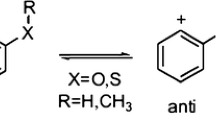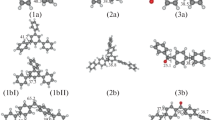Summary
Radiative decay and phosphorescence of triplet stare benzene is doubly -orbital and spin- forbidden and is only activated through vibronic coupling among the manifold of triplet states. For this reason the determination of lifetime and transition moments for the decay of triplet benzene has posed a considerable challenge to both theory and experiment. In the present work we have addressed the triplet benzene problem at several levels of theory; by truncated perturbation theory and semiempirical, CNDO/S-CI, calculations; by complete sum-over-state calculations as implemented in recentab initio multiconfiguration quadratic response (MCQR) theory; and by direct MCQR calculations of vibronic phosphorescence. The vibronic coupling is in the two former cases treated by the Herzberg-Teller (H-T) perturbation theory, involving four main mechanisms for the phosphorescent decay of triplet benzene. The results and interpretations given by these approaches as well as their merits and limitations are presented and discussed in some detail. Our calculations indicate that the phosphorescent decay of the3 B 1u state takes place predominantly through vibronic coupling along thee 2g mode. We obtain a phosphorescence that is almost completely out-of-plane polarized, which is in line with more recent measurements by the microwave-induced delayed phosphorescence technique, and could reproduce quite well the intensity ratios for different vibronic bands obtained in that experiment. The final triplet state lifetime is the result of a delicate sum of contributions from several vibronic degenerate and non-degenerate modes. The direct vibronic phosphorescence calculations predict a long lifetime, about one minute — 68 seconds for the best wavefunction — and seem to focus on a doubling of the assumed, albeit not established, “best experimental” value for the radiative lifetime of triplet benzene; ⋍ 30 seconds.
Similar content being viewed by others
References
Parr RG, Craig DP, Ross IG (1950) J Chem Phys 18:1561
Fischer-Hjalmars I (1960) Sv Kemisk tidskr 72:612
Fischer-Hjalmars I (1962) Arkiv Fysik 21:123
Fischer-Hjalmars I, Sundbom M (1968) Acta Chem Scand 22:607
Vahtras O, Ågren H, Jørgensen P, Jensen HJA, Helgaker T, Olsen J (1992) J Chem Phys 96:2118
Vahtras O, Årgen H, Jørgensen P, Jensen HJA, Helgaker T, Olsen J (1992) J Chem Phys 97:9178
Matos JHO, Roos BO, Malmqvist PÅ (1987) J Chem Phys 86:1458
Fülscher MP, Andersson K, Roos BO (1992) J Phys Chem 96:9204
Fülscher MP, Malmqvist PÅ, Roos BO (1990) In: Lakowitz LR (ed) Time-resolved spectroscopy in biochemistry II, page 322. Proc SPIE
Albrecht AC (1963) J Chem Phys 38:354
Goeppert-Mayer M, Sklar AL (1938) J Chem Phys 6:645
Shull HJ (1949) J Chem Phys 17:295
McClure DS (1952) J Chem Phys 20:682
Sklar AL (1937) J Chem Phys 5:669
Mizushima M, Koide S (1952) J Chem Phys 20:765
Clementi E (1961) J Mol Spectroscopy 6:497
Dikun PP, Sveshnikov BY (1949) Zhur Eksptl i Teoret Fiz (Soviet JETP) 19:1000
Henry BR, Siebrand W (1969) J Chem Phys 51:2396
Krishna VG, Salzman WR (1969) J Chem Phys 50:3875
Olsen J, Jørgensen P (1985) J Chem Phys 82:3235
Breit G (1929) Phys Rev 34:553
Pauli W (1927) Z Phys 43:601
Thomas LT (1927) Phil Mag 3:1
Ågren H, Vahtras O (1993) J Phys B: At Mol Phys 26:913
Hettema H, Jensen HJA, Jørgensen P, Olsen J (1992) J Chem Phys 97:1174
Vahtras O, Ågren H, Jensen HJA, to be published.
Olsen J, Yeager DL, Jørgensen P (1991) Chem Phys Lett 186:379
Jensen HJA, Ågren H (1984) Chem Phys Lett 110:140
Siegbahn PEM, Heiberg A, Almlöf J, Roos BO (1981) J Chem Phys 74:2384
Olsen J, Roos BO, Jørgensen P, Jensen HJA (1989) J Chem Phys 89:2185
Mineav BF (1979) Fizika Molecul 7:34
Mineav BF (1971) Izv Vysch Uccheb Zeved Fizika 8:118
Roche M, Jaffé HH (1974) J Chem Phys 60:1193
Nishimoto K, Mataga N (1957) Z Physik Chem 12:335
Neto M, Scrocco M, Califano S (1961) Spectrochim Acta 22:1981
Hameka HF, Oosterhoff JL (1958) Mol Phys 1:364
Mizushima M, Koide S (1953) J Chem Phys 20:765
Veeman WS, Van der Waals JH (1970) Mol Phys 18:63
Knuts S, Vahtras O, Ågren H (1992) THEOCHEM 279:249
Ågren H, Vahtras O, Knuts S, to be published.
Dunning Jr TH (1970) J Chem Phys 53:2833
Dunning Jr TH (1971) J Chem Phys 55:716
Sadlej A (1988) Collection Czech Chem Commun 53:1995
Jensen HJA, Ågren H (1986) J Chem Phys 104:229
Jørgensen P, Olsen J, Jensen HJA (1988) J Chem Phys 74:265
Helgaker TU, Almlöf J, Jensen HJA, Jørgensen P (1986) J Chem Phys 84:6266
Helgaker TU, Taylor PR (1992) Unpublished
Jensen HJA, Jørgensen P, Ågren H, Olsen J (1988) J Chem Phys 88:3824
Roos BO, Andersson K, Fülscher MP (1992) Chem Phys Lett 192:5
McGlynn SP, Azumi T, Kinoshita M (1969) Molecular Spectroscopy of the Triple State. Prentice Hall, Englewood Cliffs, NJ
Doering JP (1969) J Chem Phys 51:2866
The oscillator strengths are obtained with theE-factor given by the excitation energy to the3 B 1u state as given by experiment (the MCLR energy deviates only minorly, see Table 1).
Rabalais JW, Maria HJ, McGlynn SP (1969) J Chem Phys 51:2259
van Egmond J, van der Waals JH (1973) Mol Phys 26:1147
Bendazolli GL, Palmieri P (1974) Int J Quant Chem 8:941
Langhoff SR, Davidson ER (1976) J Chem Phys 64:4699
Phillips P, Davidson ER (1982) J Chem Phys 86:3729
Colson SD, Bernstein ER (1965) J Chem Phys 43:2661
Wright MR, Frosch RP, Robinson GW (1960) J Chem Phys 33:934
Colson SD, Robinson GW (1968) J Chem Phys 48:2550
Johson PM, Koronowski GM (1983) Chem Phys Lett 97:53
Author information
Authors and Affiliations
Additional information
Dedicated to Inga Fischer-Hjalmars on her 75th birthday
Rights and permissions
About this article
Cite this article
Knuts, S., Minaev, B.F., Ågren, H. et al. The phosphorescence of benzene obtained byab initio and semi-empirical calculations. Theoret. Chim. Acta 87, 343–371 (1994). https://doi.org/10.1007/BF01113390
Received:
Accepted:
Issue Date:
DOI: https://doi.org/10.1007/BF01113390




